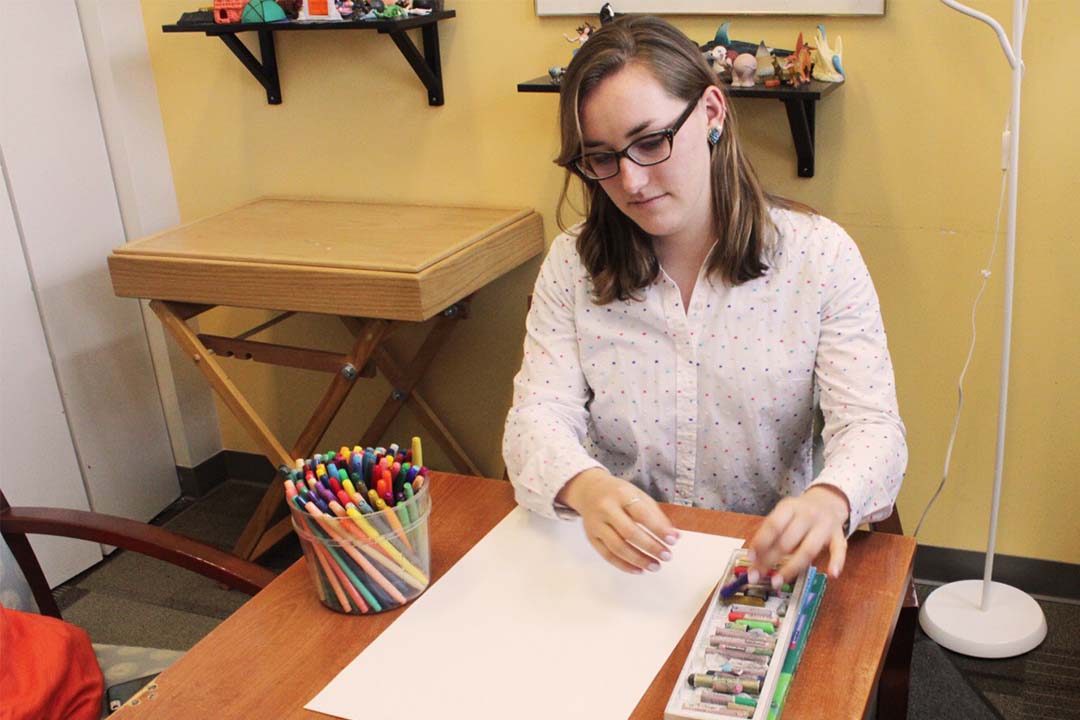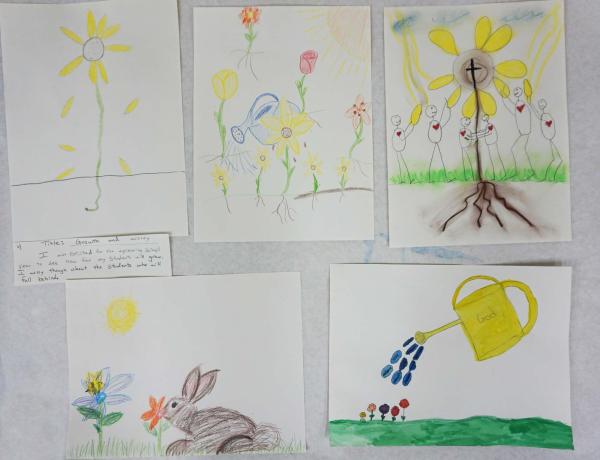In an Oklahoma elementary school, Christina Hagemeier, a second-year graduate student in the CCAS Art Therapy Program, prepares her class for an assignment. She hands out art supplies—paint, colored pencils, chalk pastels—and asks them to draw a picture that describes how they feel about the beginning of the school year.
The portraits are decidedly downbeat: Droopy flowers dropping petals on the ground. Clocks with hands spinning impossibly fast. To Hagemeier, they represent exhaustion, trepidation and a lack of hope about classes resuming.
But Hagemeier’s students aren’t children—they’re teachers. As part of her graduate research, Hagemeier traveled to Oklahoma to test the effectiveness of art therapy in combating teacher burnout. In a day-long workshop, she asked 11 teachers to use art tools to wordlessly express their emotions about their jobs. Most initially responded with portraits of frustration and stress. But pictures drawn later in the session, after the teachers reviewed their colleagues' artwork, showed images of empathy such as watering cans nourishing rejuvenated gardens.
“The power of the visual image allowed these people to create supportive responses without having to say a word,” said Hagemeier, who displayed her findings at GW Research Days, the annual two-day celebration of student research. “Through artwork, we were basically able to have a more fruitful and rejuvenating conversation in a few hours than most of these teachers experienced in an entire school year.”
While art therapy still faces challenges winning acceptance in much of the health care world, studies continue to suggest that the widely-respected academic discipline has beneficial effects for a range of populations—from trauma sufferers like combat veterans to children with autism to professionals battling stress and job burnout.
“Professional burnout is a major cause of employee unhappiness and dissatisfaction,” said Assistant Professor of Art Therapy Jordan S. Potash, Hagemeier’s project advisor. “Art therapy addresses [burnout] by engaging the creative process to re-energize people while identifying commonalities and empathy with coworkers.”
Teachers may be particularly susceptible to burnout—which, for her study, Hagemeier defined as “a chronic and persistent feeling of being ineffective and unappreciated.” The profession has long been beleaguered by stresses such as long hours, low salaries and large class sizes. About half a million U.S. teachers—15 percent of the entire profession—leave their jobs every year. An American Federation of Teachers survey reported that 73 percent of teachers say they are “often” under stress while 55 percent described their morale as “low or very low.”
“This is what happens when you are juggling kids, supplies, a lack of communication, a lack of resources,” said Hagemeier, whose mother is a teacher. Hagemeier herself is currently an art therapy intern at Saratoga Elementary School in Fairfax County, Va. “Teachers are inherently empathetic and giving of themselves. But when you are constantly under pressure, eventually your empathy tank gets depleted.”
With Potash’s guidance, Hagemeier built on previous art therapy studies by investigating how art therapy-based protocols might lessen the effects of teacher burnout, including feelings of isolation and stress, while creating space for teachers to support other struggling educators. Her approached tested art therapy’s ability to create a “metaphoric language,” as she put it, to foster communication among coworkers and open dialogues about stress and frustration in the workplace.
None of the volunteers were told that the workshop specifically dealt with teacher burnout. But when instructed to create art that represented their emotions about their job, they unfailingly suggested degrees of emotional exhaustion and depersonalization. The fast-moving clock signified the stress of juggling student needs with time constraints. The falling petals represented teachers’ worries that some students get left behind. “All of us care about every kid but in the back of my mind I am always thinking, ‘I should have done this or I should have done that,’” one teacher commented.
The teachers were then given 10 minutes to silently view all of the artwork and were then tasked with responding through a new picture. The response artwork—helping hands repairing sad flowers, watering cans reviving gardens—projected more resiliency and hope than the initial art, Hagemeier said, while emphasizing the support of fellow teachers.
In the study, teachers responded to the ‘droopy flower’ drawing (top left corner) with pictures of support.
In a post-workshop discussion, teachers told Hagemeier that the artwork forum felt like a safe environment to discuss their struggles, while the responses showed that they weren’t alone. By expressing themselves through art, most of the teachers said they could connect with other teachers feeling the same frustrations.
“The biggest takeaway for me is the power of communicating in a different language,” Hagemeier said. “Simply by removing their normal voices and word use and replacing that tool of communication with art, teachers felt more comfortable sharing their concerns and offering others their support.”
Hagemeier hopes to expand her research after she graduates and attains her art therapy license. Meanwhile, she’s an artist herself, specializing in abstract realism landscapes, and employs her own art therapy techniques at her internship when stress weighs heavily on her. “The Art Therapy Program encourages us to have an identity as an artist as well as an art therapist,” she said. “As an artist, you are already naturally curious and open to experimentation. That’s what we ask for in the therapy room too: be open, be curious and be willing to look at things in a way you may never have before.”



